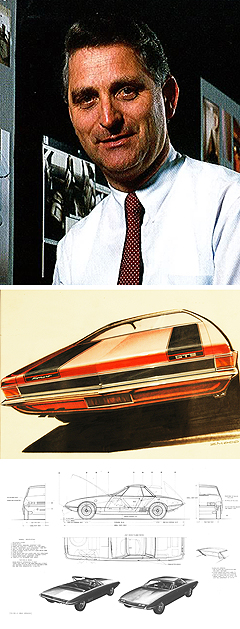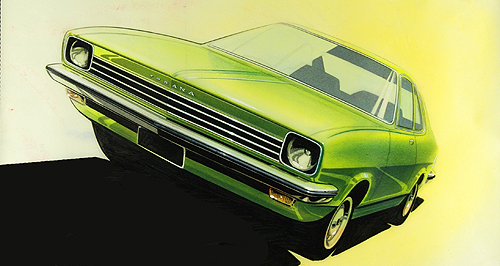Make / Model Search
News - General NewsExhibition honours Holden design chiefLion king: The Holden Torana in a 1970s concept sketch done by then Holden designer Phillip Zmood. Museum display charts the career of former Holden designer Phil Zmood13 Jul 2010 By IAN PORTER MELBOURNE’S RMIT University is set to honour one of its successful past students, former Holden chief designer Phillip Zmood, with an exhibition of his design sketches that include of some of Holden’s iconic models. Mr Zmood became the first Australian to be appointed Holden chief designer in a 37-year career with GM design, influencing or having a hand in the design of 75 per cent of all Holdens, including Toranas, Monaros and Commodores. He had a big hand in the HQ series, which was brought down by the 1970s oil shocks, and was chief designer for Holden’s answer to the same problem, the Torana. Setting a precedent others would follow, Zmood got the call to work in Europe and, later in his career, the United States. The exhibition at the Melbourne Museum, from Friday July 16 to Sunday August 8, traces his work from sketches he did as a student at RMIT – where he studied in the 1960s – to his Holden designs.  Left: Phillip Zmood in his Holden days. Below: Some of his design sketches. Left: Phillip Zmood in his Holden days. Below: Some of his design sketches.Mr Zmood was about to throw out the works, which include production drawings, when someone suggested he donate them to the RMIT, where he was a course advisor for 15 years. The grandson of Russian immigrants who landed in Melbourne in 1910, Zmood was directed towards a tertiary qualification. “My parents were very keen on education,” he said. “They couldn’t pass on a fortune, but they could give me an education, which they saw as the first rung on the ladder.” He attended the Caulfield Technical School before studying industrial design at Royal Melbourne Institute of Technology, now RMIT University. “I kept entering a British car design contest and one year I won it with a design for a sports car,” he said. “(The Gannet 1000) was about the size of an MG but had a rotary engine over the rear wheels and a folding metal roof.” This prompted some coverage in a daily paper and was part of a portfolio which led to an offer of work from Holden, which was not immediately accepted. He finally got over his suspicions about big companies and took up the offer, right at the time GM was gearing up Holden to play a large role in the region. “They were making 300,000 cars then – treble what they do today – and Detroit had a big vision for Australia,” he said. “An American named Joe Schemansky was appointed the first design director and he built what is still the design centre, at a time when there was only a fraction of the work they do now.” But it was clear he was expected to work hard. “At my first interview, I was asked whether I minded working overtime. It turned out we mostly worked to 9pm three nights a week and most Saturdays. “My wife reckons I used to go to work on Tuesday and come home on Thursday.” When he reported for duty, he was shown into a large room furnished with a single desk. “Just draw cars” was his instruction, and he duly covered the walls with exotic renderings. He started out on small items. He remembers doing the Holden badge that went onto the HR grille, but was soon involved in the ground-breaking HK range, which saw the introduction of Australia’s most loved two-door, the Monaro. He did some wheel covers and badges for that range. In the late 1960s he was a contributor to the HQ series – he is still a fan of taillights in the bumper bar – but it was when he was appointed chief designer in the Torana studio in 1969 – still only in his late 20s – that he came to the fore. The GTR-X concept coupe he designed broke cover in 1970, just as the XU-1 sports model started tearing up the racetracks. The Torana was a big hit, even the thirsty six cylinder models. The GTR-X – many thought it should have been named the XU-2 – was the most beautiful thing ever designed in Australia and the show car GMH built wowed crowds wherever it went. “GM could see the small Japanese cars coming and the Torana was the model designed to meet the competition,” Mr Zmood said. “It didn’t have the same economy or packaging, but the LH model gave Australia its first hatchback.” That hatchback later also performed well on the racetracks as the V8-engined A9X model. A two-year stint at Opel starting in 1978 was abruptly cut short after about a year when Zmood was recalled to be assistant to the design director Leo Pruneau. “We had to work on the VK and VL Commodores, which we saw as the survival cars for GMH.” The company was almost bankrupt as the Ford Falcon had been dominating the sales charts after the oil crises abated. GMH was in big financial trouble, Zmood said. “I remember being told at the time, we had to make a success of the VL or we would be looking for another job.” They inserted an extra window behind the C pillar to give it a six-window glasshouse and make it look bigger in comparison with the Falcon. The VL model finally ditched the old Holden straight six and was replaced with a sophisticated Nissan I6. “That really took off,” Zmood said. “The VK and the VL were the turning point for the company.” In 1983, Mr Zmood became the first Australian to be appointed director of Holden design and held the position until 1995. The company’s return to financial health – built on rear-wheel-drive large cars – caught the attention of people in the Detroit head office. GM was trying to bring its various subsidiaries closer in to the centre and, as part of this, Holden was asked to design and build a concept car for Buick, which became the XP2000 of 1995. Soon after, Mr Zmood was asked to live in Detroit and be Holden’s representative in the various global programs in which Australia had an interest. In fact, he also represented the other non-American subsidiaries such as Opel. “That was the start of the Global rear-wheel drive program. All of a sudden we had gone from being considered colonial nobodies to ‘we really respect what you guys have done because you were able to turn around your fortunes’,” he said. The Global RWD program sees Holden at the centre of GM’s development and engineering of rear-wheel-drive cars, most notably the development of the current Camaro sports coupe range. In 1998, Mr Zmood was appointed the first director of design in China, where GM had a joint venture with Shanghai Automotive. He hired all the people now the senior managers in what is called he Pan Asian Technical Automotive Centre. He returned to Australia in 2001 and became head of planning for the VE and WM launch program. Again, Holden was only marginally profitable and needed some quick success with the new Commodore range. “We prepared the WM long wheelbase car as the first major variant because we needed something to export quickly to help recoup the investment,” he said. Since he retired in 2002, Zmood has been running a small consultancy called Euro Design Associates. He finds his main role in life now is to help manufacturers understand that it pays to involve designers early in a project’s life, not when the product is nearing the production line and is suddenly seen to be deficient in some areas.  |
Click to shareGeneral News articlesResearch General News Motor industry news |









Facebook Twitter Instagram